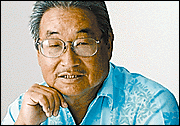Advertisement - Click to support our sponsors.


Sports Watch
KAHUKU'S stunning victory in the state championship game, ending St. Louis' 14-year domination, was the best thing that could have happened to local high school football. Class system
a ways off in
prep footballThat said, there's still a need for a reality check.
Kahuku's 26-20 victory shouldn't be viewed as bragging rights for the public schools over the private schools like in the days of the old Interscholastic League of Honolulu.
While the Red Raiders struck a blow for the public schools, keep in mind that Kahuku isn't your typical OIA school.
It is to the rest of the OIA, with the possible exception of Waianae, what St. Louis is to the ILH.
Namely, a 500-pound gorilla that the other schools in their leagues have to face week in and week out.
In the OIA, you can't blame Aiea for not looking forward to playing Kahuku. In the ILH, what fun can it be for undermanned Damien having to play St. Louis twice a season?
Both St. Louis and Kahuku figure to dominate their respective leagues for years to come. It's nothing new.
Last Friday's clash of the titans was the sixth time - counting four Prep Bowls - that they played each other for the football championship.
"After Kahuku and maybe Waianae, there's a big drop-off in the OIA," said Dwight Toyama, the league's executive director.
The same can be said for the ILH. After St. Louis and Kamehameha - the ILH's Waianae - there's a big fall-off in football talent. Both carry 100 players on their rosters.
The situation is exacerbated in the six-team ILH because Damien and Pac-Five, a conglomerate of smaller private schools, can hardly field enough players to be competitive in football.
It's hard enough even for Punahou and Iolani - the other two ILH schools - to keep up despite their resources.
SO there has been a lot of talk about classifying the teams according to relative strengths, or about getting back to the days of the old ILH when the city's five public schools played in the same league with the private schools.
I attended a meeting of Honolulu public school athletic directors when they recommended breaking away from the private schools because the playing field wasn't level. Recruiting had tilted it.
"People forget what it was like 30 years ago. I don't think the public knows why," said Toyama, who experienced it first hand playing for Kaimuki High when it was in the ILH.
"Things haven't changed. If anything, recruiting has escalated."
So it won't be anytime soon, if ever, that the two leagues will merge to form separate divisions based on relative strength in football.
According to Toyama, the OIA has enough problems of its own to worry about the ILH's.
"What would we gain? Why would we want to inherit their problems?"
Besides, it's only in football that the ILH really needs merging.
Punahou might take its lumps from St. Louis in football, but it's perfectly content in the ILH because it dominates most of the other sports.
Football poses its own problems - besides some depressing lopsided scores - because safety is a major concern. It's an inherently dangerous sport in which numbers and physical size are key factors.
The OIA has developed its own system of classification, forming two divisions and moving three teams each from one to the other based on performances from the previous year.
It's far from ideal. But at least half of the league doesn't have to play Kahuku.